The Best Broom in the World: A Repurposed Tobacco Stick and Appalachian Craftsmanship
There’s something magical about the historic Eight Mile Loop in Gatlinburg, Tennessee. This winding road through the foothills of the Great Smoky Mountains leads visitors through the largest group of independent artisans in North America. Known as the Great Smoky Arts & Crafts Community, these paths connect over 100 craftsmen, artists, and artisans who keep traditional crafts alive, turning simple materials into extraordinary pieces. It was on a recent family trip to Gatlinburg, during a morning tour through the craft community, when I discovered what would become the finest broom I’ve ever owned – a masterpiece that merged traditional broom making with the historic charm of a reclaimed tobacco stick.
Tucked away in a small back room behind Cliff Dwellers Gallery, I found Ogle’s Broom Shop, a place where time seems to stand still. You could almost miss the door in the back of the art gallery, but I happened to find his external door while walking back from another neighboring building. It is one single room, and not a lot of space to work. The proprietor, David Ogle, sat in a simple wooden chair, his practiced hands weaving twine through authentic broom corn bristles, continuing a family tradition that apparently spans three generations of Appalachian craftsmen.
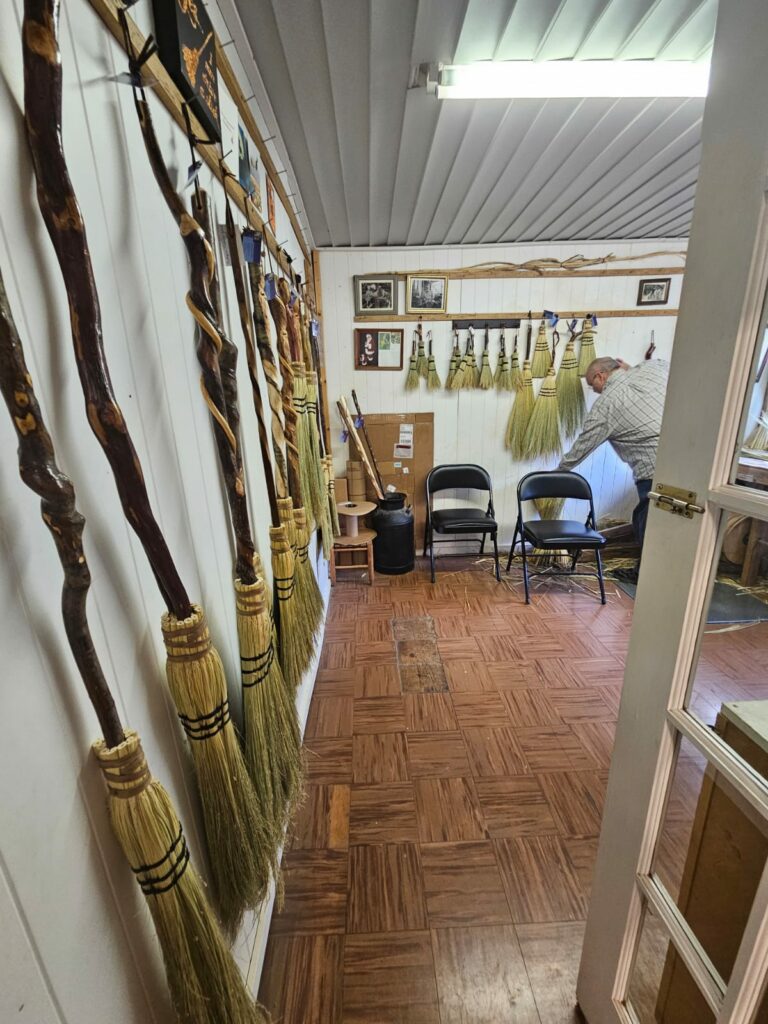
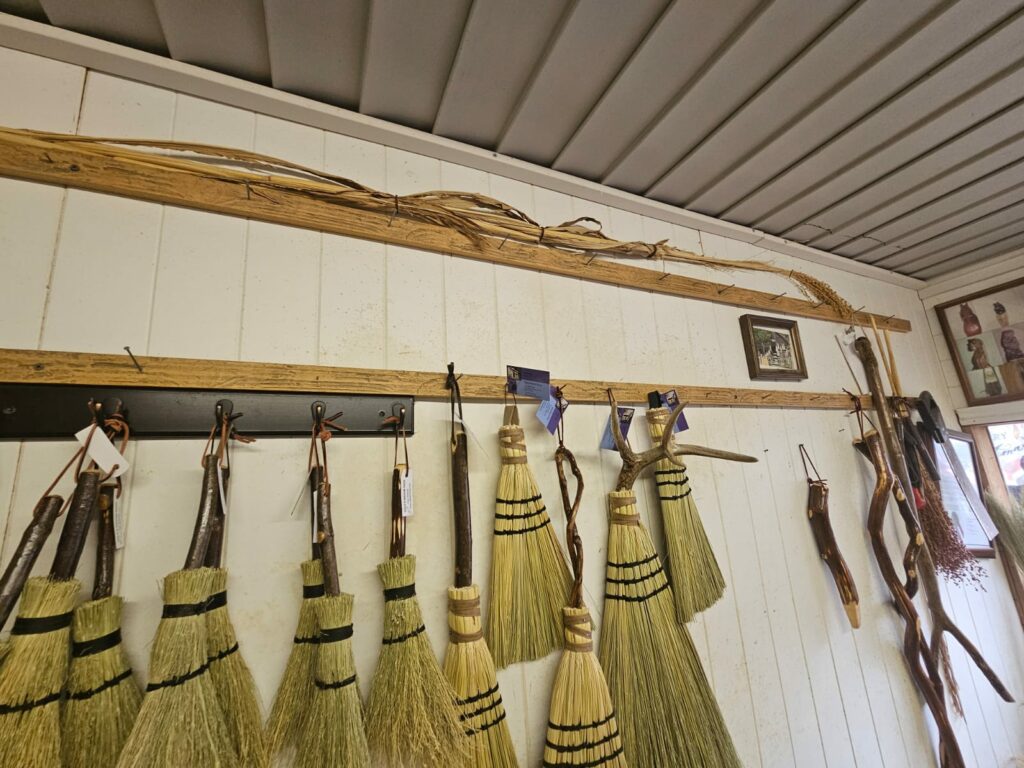
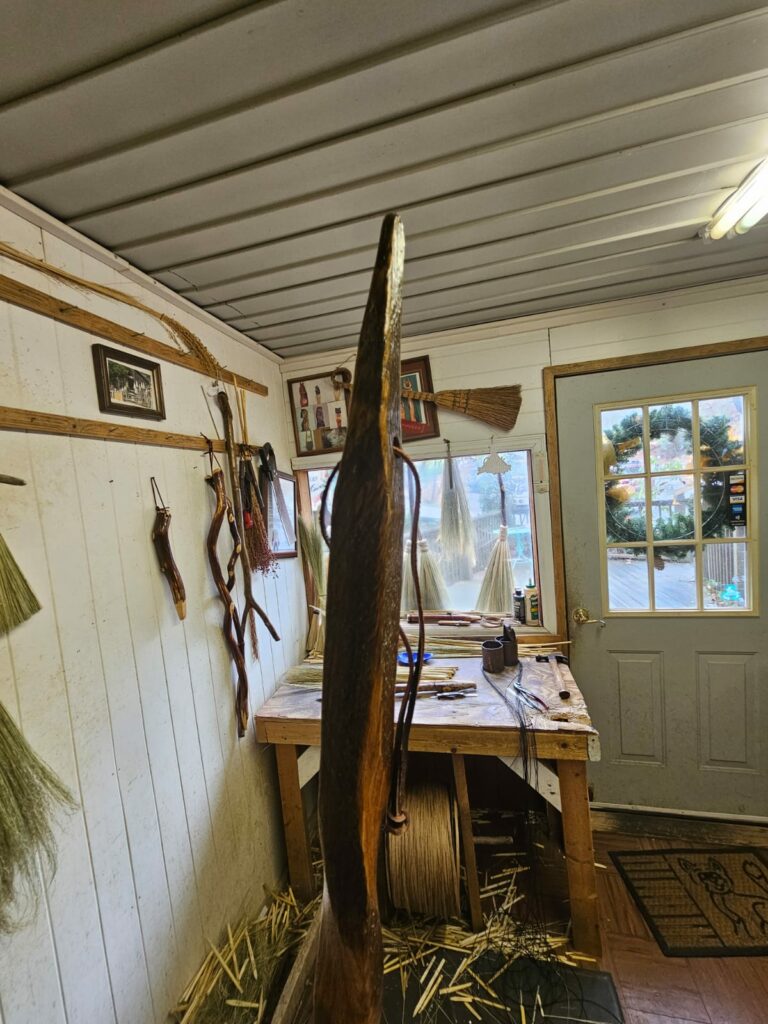
Understanding Broom Corn: A Traditional Craft Material
Before I share more about the remarkable broom I got to take home (did I mention it’s the BEST broom I have ever used?), it’s worth understanding what makes broom corn special. Despite its name, broom corn isn’t corn at all – it’s a variety of sorghum (Sorghum vulgare var. technicum). This fascinating plant produces long, sturdy fibers that have been used for making brooms since colonial times. The plant grows tall, sometimes reaching heights of 15 feet, with seeds growing on fibrous stalks that, when dried and processed, create perfect bristles for sweeping.
The Marriage of Two Traditional Crafts
As I watched the artisan work, my eyes were drawn to a particularly beautiful handle he was using. Years of working with reclaimed wood made me recognize its distinctive character immediately. It was OLD, and its shape was unique. It made me think about some prior projects I have done with some SUPER cool sticks.
“Have you ever considered using an old tobacco stick for a handle?” I asked, curious about combining these two traditional crafts.
The craftsman’s eyes lit up as he smiled, reaching towards a stack behind his chair, and standing up in the corner of the room. “Like this one?” he asked, producing what would soon become my prized weapon against dust bunnies and spilled Cheerios.
In his hands was a piece of American farming and crafting history – a red oak tobacco stick, carefully selected and skillfully transformed into the handle of a traditional broom. The wood’s grain and coloring held stories of its previous life on a tobacco farm, where it had served faithfully in the crucial process of drying and curing tobacco leaves. It had been likely handled 100s of times in the harvesting, drying, and sorting process on an American Tobacco farm somewhere. It had been hewn and cut into this very specific tool of farming, and had absorbed DECADES of sweat, tobacco oils, and mud from likely multiple generations of laborious farming. But now, in the hands of this skilled artisan, it was beginning a second life as something entirely new. I hate to say it makes me emotional to think about the lives that have come in contact with this lil ole stick and how amazing it is to get to “save it” and bring it to my home as a prized addition to the household, but I would be lying if I tried to deny a true feeling of depth thinking about it at that moment! Well, and maybe even a bit now as I write this….
Craftsmanship in Action
The transformation from farm tool to broom handle was a testament to Appalachian ingenuity. The craftsman had carefully carved a rugged spiral pattern along the handle’s length, a detail that not only added beauty but also provided a natural grip and even more unique character. A clear, protective coating brought out the red oak’s rich color while ensuring the wood’s longevity in its new role.
I told him I had to buy that one. It was awesome. He told me it actually wasn’t finished, and still needed a bit more work before I could take it… I asked him how long I would have to wait, and he smiled and said “oh, about 2 minutes”. As I watched, he completed the final steps of the broom’s creation. With practiced movements, he double checked to make sure all the bristles and twine were in place and tight. The final touch was using what looked to be an old but efficient chopping tool, trimming the bottom to ensure a perfectly level sweep – a crucial detail that would affect the broom’s performance for years to come.
More Than Just a Broom
What makes this broom special goes beyond its practical function. Every time we use it, we’re handling a piece that connects multiple strands of American craft heritage:
- The tradition of tobacco farming that produced the original stick, including the related acts of harvesting and milling a red oak tree.
- The resourcefulness of reclaiming and repurposing materials to be effective but also frugal in our actions, which has been a key component of Appalachian life for generations.
- The enduring art of Appalachian broom making, which is something that most people never realize when they buy their disposable broom from WalMart.
- The skilled craftsmanship that brings these elements together, and the tenacity of Mr. Ogle to spend his time carrying on a family tradition and being there for MY family to enjoy through visiting his shop, visiting with him, and being able to buy a true example of PURE Americana.
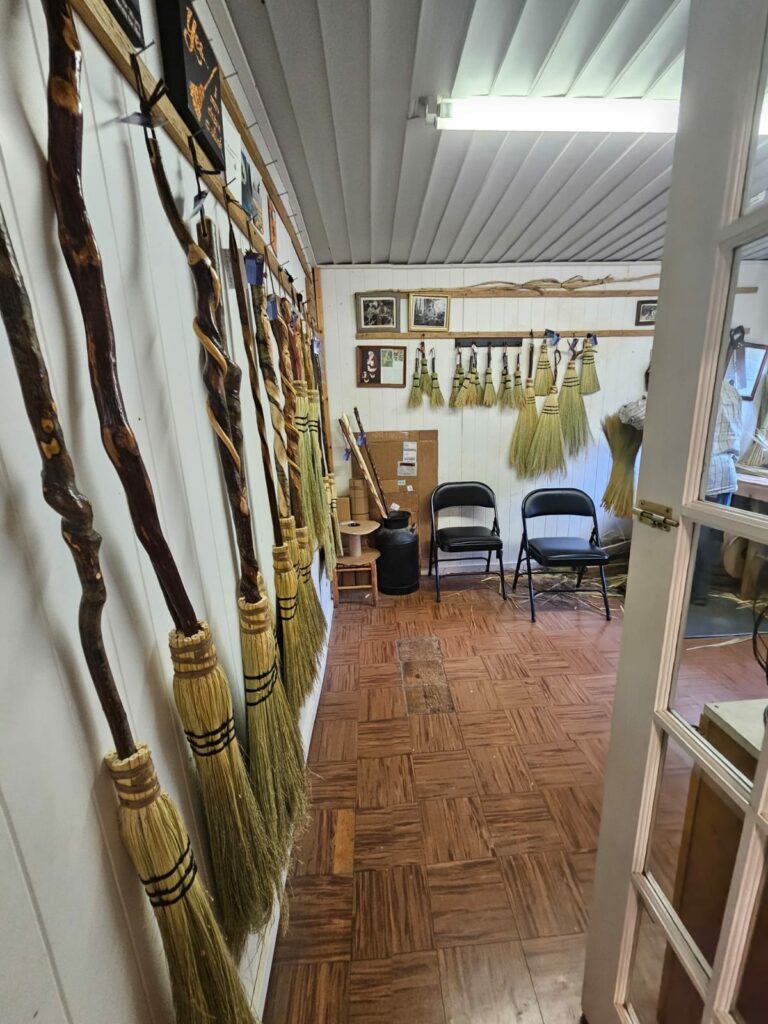
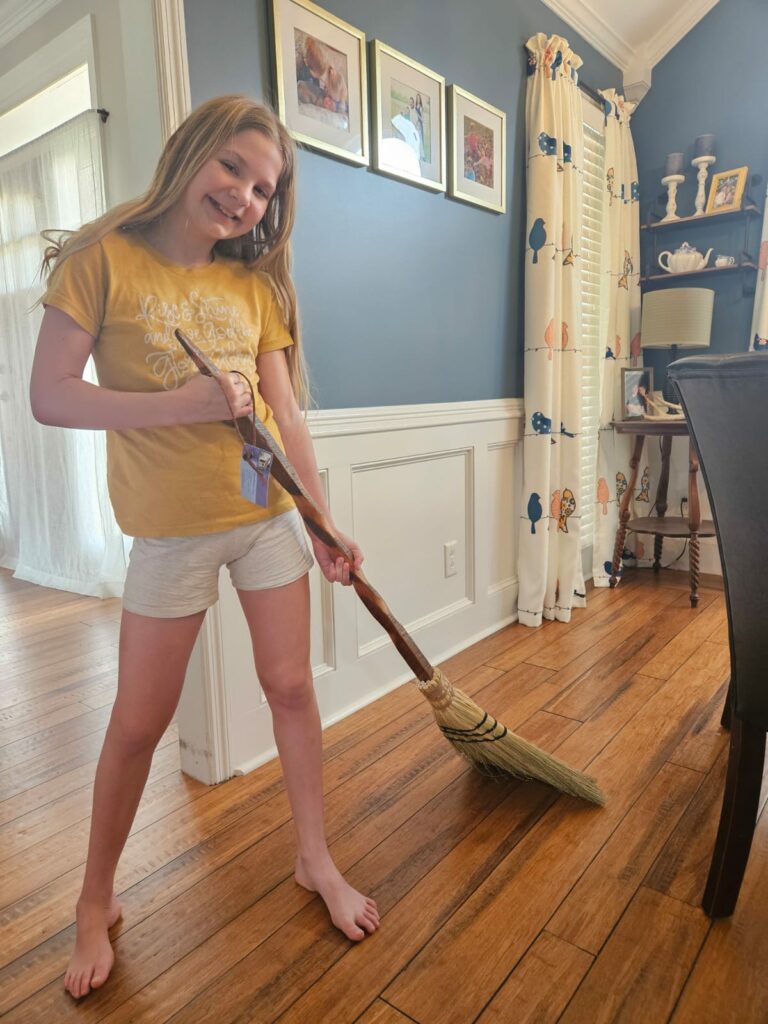
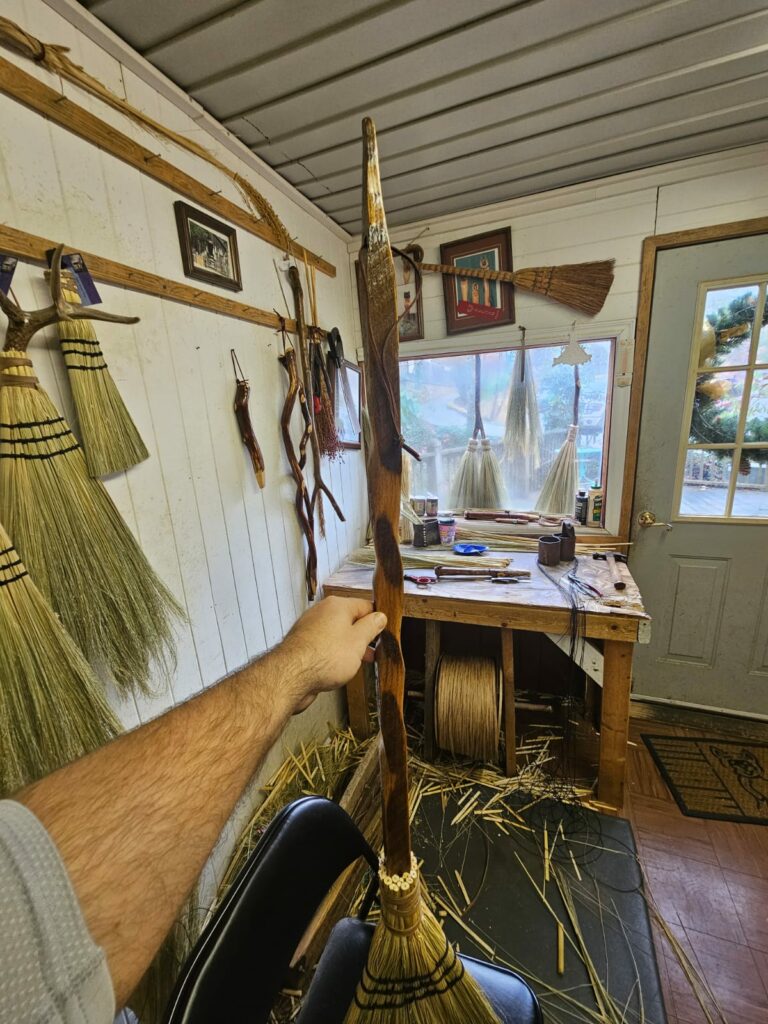
The Value of Traditional Craftsmanship
In an age of mass-produced household items, this broom stands as a testament to the value of handcrafted goods. The red oak tobacco stick handle has a warmth and character that no plastic or mass-produced wood handle could match. The carefully wound bristles sweep more effectively than any store-bought broom I’ve ever used. For real. I will even admit that when I loaded it in the back of the ole Honda Odyssey “Family Truckster” (in reference to the ole Chevy Chase family vacation movies), I expected it to be a cool conversation piece in the house. I didn’t think we would use it regularly. Well, that changed when we got home and my wife put bristles to the floor. No joking, best broom ever judged by effective gathering of debris.
Cool side note: Mr. Ogle did say that with normal household use, we should expect it to work for a LOT of years without wearing out. But if we damaged it or somehow wore it out, we could bring it back and he would repair it with a new set of bristles for a few bucks. Pretty cool…
A Daily Reminder of American Craft Heritage
Now, whether it’s my kids sweeping the kitchen where they likely spilled something while horse-playing, my wife attacking a rogue spider that made its way in the back door, or myself cleaning up the dirt that I usually track into the laundry room, this broom serves as a daily reminder of American crafting heritage.
This broom, crafted by the skilled hands of a third-generation Ogle family craftsman, represents more than just a well-made cleaning tool. It’s a perfect example of how reclaimed tobacco sticks can be transformed into beautiful, functional items that honor their agricultural heritage while serving a new purpose. Like the other artisans along the Eight Mile Loop – the weavers, potters, carvers, and painters – the Ogle family proves that traditional crafts sometimes have a lot more history and “story” than we realize. For example, most people that wandered into that little shop would see that broom as “maybe having a cool old handle”, and not realize the depth of the history and toil embedded in that “stick”. (Thankfully, I now get to partner with old farms to preserve that history and beauty, while helping educate people about these unique slices of wood). As we continue to value and preserve these traditional crafting methods, we ensure that future generations can appreciate the beauty of handmade items and the stories they tell.
What other ideas do you have for using these sticks? Have you seen any other cool uses, or have any examples handy? I would LOVE to see what you’ve got, and I can share that inspiration with my followers and keep the use of these ole sticks thriving! Shoot me an email to tim@wholesaletobaccosticks.com. And if you want to get your hands on some authentic reclaimed sticks to bring your own ideas to life, we have a large inventory that is ready to be used now!